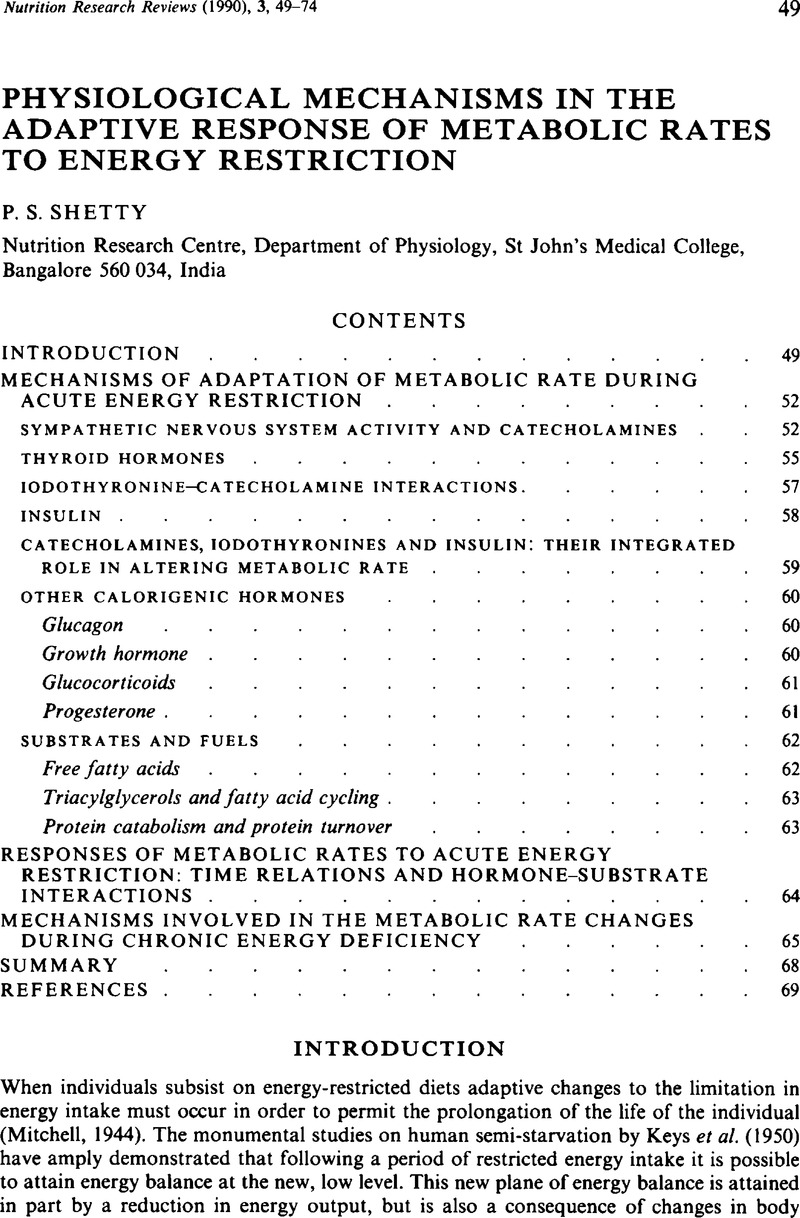Crossref Citations
This article has been cited by the following publications. This list is generated based on data provided by Crossref.
YOUNG, VERNON R.
YU, YONG‐MING
and
FUKAGAWA, NAOMI K.
1991.
Protein and Energy Interactions Throughout Life1.
Acta Paediatrica,
Vol. 80,
Issue. s373,
p.
5.
Vernon, Richard G.
1992.
Effects of diet on lipolysis and its regulation.
Proceedings of the Nutrition Society,
Vol. 51,
Issue. 3,
p.
397.
Vaz, Mario
Jayarajan, M.P.
Kulkarni, R.N.
Balasubramanyam, A.
and
Shetty, P.S.
1992.
Parasympathetic tone in chronic energy deficient human subjects.
Nutrition Research,
Vol. 12,
Issue. 4-5,
p.
613.
le Moullac, BÉatrice
Gouache, Patricia
and
Bleiberg-Daniel, Fanny
1992.
Regulation of Hepatic Transthyretin Messenger RNA Levels during Moderate Protein and Food Restriction in Rats.
The Journal of Nutrition,
Vol. 122,
Issue. 4,
p.
864.
Ulijaszek, Stanley J.
1992.
Human energetics methods in biological anthropology.
American Journal of Physical Anthropology,
Vol. 35,
Issue. S15,
p.
215.
Kulkarni, R.N.
and
Shetty, P.S.
1992.
Net mechanical efficiency during stepping in chronically energy-deficient human subjects.
Annals of Human Biology,
Vol. 19,
Issue. 4,
p.
421.
Oosting, S. J.
Boekholt, H. A.
Los, M. J. N.
and
Leffering, C. P.
1993.
Intake and utilization of energy from ammonia-treated and untreated wheat straw by steers and wether sheep given a basal diet of grass pellets and hay.
Animal Science,
Vol. 57,
Issue. 2,
p.
227.
Puri, Punita
Mahapatra, S. C.
Bijlani, R. L.
Prasad, H. K.
and
Nath, I.
1994.
Feed efficiency and splenic lymphocyte proliferation response in yogurt- and milk-fed mice.
International Journal of Food Sciences and Nutrition,
Vol. 45,
Issue. 4,
p.
231.
Wolkers, J
Wensing, T
Bruinderink, G.W.T.A.Groot
and
Schonewille, J.Th
1994.
The effect of undernutrition on haematological and serum biochemical variables in wild boar (Sus scrofa).
Comparative Biochemistry and Physiology Part A: Physiology,
Vol. 108,
Issue. 2-3,
p.
431.
Nap, R.C.
and
Hazewinkel, H.A.W.
1994.
Growth and skeletal development in the dog in relation to nutrition; a review.
Veterinary Quarterly,
Vol. 16,
Issue. 1,
p.
50.
Wolkers, J.
Wensing, Th.
Schonewille, J.Th.
and
van't Klooster, A.Th.
1994.
Comparative Nutrition Papers Undernutrition in relation to changed tissue composition in wild boar (Sus scrofa).
Comparative Biochemistry and Physiology Part A: Physiology,
Vol. 108,
Issue. 4,
p.
623.
Carbonnel, Franck
Messing, Bernard
Darmaun, Dominique
Rimbert, Agnès
Rongier, Monique
Rigal, Odile
Koziet, Joseph
Thuillier, François
and
Desjeux, Jehan François
1995.
Energy and protein metabolism in malnutrition due to nonneoplastic gastrointestinal diseases.
Metabolism,
Vol. 44,
Issue. 9,
p.
1110.
Bross, R
and
Hoffer, LJ
1995.
Fluoxetine increases resting energy expenditure and basal body temperature in humans.
The American Journal of Clinical Nutrition,
Vol. 61,
Issue. 5,
p.
1020.
Laflamme, DP
and
Kuhlman, G
1995.
The effect of weight loss regimen on subsequent weight maintenance in dogs.
Nutrition Research,
Vol. 15,
Issue. 7,
p.
1019.
Kempen, KP
Saris, WH
and
Westerterp, KR
1995.
Energy balance during an 8-wk energy-restricted diet with and without exercise in obese women.
The American Journal of Clinical Nutrition,
Vol. 62,
Issue. 4,
p.
722.
SANTOSO, U.
TANAKA, K.
and
OHTANI, S.
1995.
Early Skip-a-Day Feeding of Female Broiler Chicks Fed High-Protein Realimentation Diets. Performance and Body Composition.
Poultry Science,
Vol. 74,
Issue. 3,
p.
494.
Ortigues, Isabelle
and
Durand, D.
1995.
Adaptation of energy metabolism to undernutrition in ewes. Contribution of portal-drained viscera, liver and hindquarters.
British Journal of Nutrition,
Vol. 73,
Issue. 2,
p.
209.
Arieli, A.
Schrama, J.W.
Van Der Hel, W.
and
Verstegen, M.W.A.
1995.
Development of Metabolic Partitioning of Energy in Young Calves.
Journal of Dairy Science,
Vol. 78,
Issue. 5,
p.
1154.
Norgan, N. G.
and
Ferro‐Luzzi, A.
1996.
Comprehensive Physiology.
p.
1391.
Pichard, Claude
Kyle, Ursula G.
Slosman, Daniel O.
and
Penalosa, Begonia
1996.
Energy expenditure in anorexia nervosa: can fat-free massas measured by bioelectrical impedance predict energy expenditure in hospitalized patients?.
Clinical Nutrition,
Vol. 15,
Issue. 3,
p.
109.



